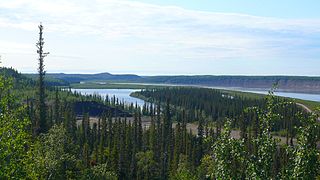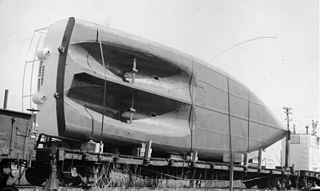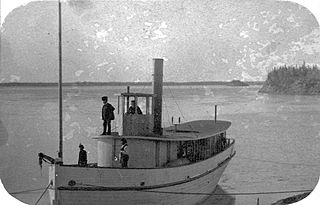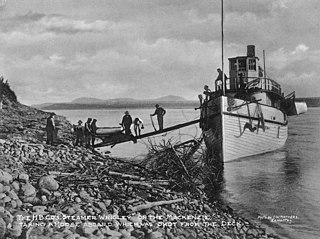
The Athabasca River is a river in Alberta, Canada, which originates at the Columbia Icefield in Jasper National Park and flows more than 1,231 km (765 mi) before emptying into Lake Athabasca. Much of the land along its banks is protected in national and provincial parks, and the river is designated a Canadian Heritage River for its historical and cultural importance. The scenic Athabasca Falls is located about 30 km (19 mi) upstream from Jasper.

The Mackenzie River is a river in the Canadian boreal forest. It is the longest river system in Canada, and includes the second largest drainage basin of any North American river after the Mississippi.

The Peace River is a 1,923-kilometre-long (1,195 mi) river in Canada that originates in the Rocky Mountains of northern British Columbia and flows to the northeast through northern Alberta. The Peace River joins the Athabasca River in the Peace-Athabasca Delta to form the Slave River, a tributary of the Mackenzie River. The Finlay River, the main headwater of the Peace River, is regarded as the ultimate source of the Mackenzie River. The combined Finlay–Peace–Slave–Mackenzie river system is the 13th longest river system in the world.

Fort Smith is a town in the South Slave Region of the Northwest Territories (NWT), Canada. It is located in the southeastern portion of the Northwest Territories, on the Slave River and adjacent to the Northwest Territories/Alberta border.

The Slave River is a Canadian river that flows from the confluence of the Rivière des Rochers and Peace River in northeastern Alberta and empties into Great Slave Lake in the Northwest Territories. The river's name is thought to derive from the name for the Slavey group of the Dene First Nations, Deh Gah Got'ine, in the Athabaskan language. The Chipewyan had displaced other native people from this region.

The Radium King was built in 1937 to haul ore on the Mackenzie River, and her tributaries. This included uranium used in the US atom bombs of World War II. Later in her active career she hauled barges on Great Slave Lake.

The Mackenzie Northern Railway is a 602-mile (969 km) Canadian railway operating in Alberta and the Northwest Territories. It is the northernmost trackage of the contiguous North American railway network. Since being purchased by CN in 2006, it has been officially known as the Meander Subdivision.

The Methye Portage or Portage La Loche in northwestern Saskatchewan was one of the most important portages in the old fur trade route across Canada. The 19 km (12 mi) portage connected the Mackenzie River basin to rivers that ran east to the Atlantic. It was reached by Peter Pond in 1778 and abandoned in 1883 when steamboats began running on the Athabasca River with links to the railroad. It ranks with Grand Portage as one of the two most important and difficult portages used during the fur trade era.

Northern Alberta is a region located in the Canadian province of Alberta.

The Peace River, which flows from the Rocky Mountains in British Columbia to the Peace–Athabasca Delta and Lake Athabasca in Alberta, was navigable by late nineteenth and early twentieth century steamboats from the Rocky Mountain Falls at Hudson's Hope to Fort Vermilion, where there was another set of rapids, then via the lower Peace from Vermilion to Lake Athabasca. The Peace is part of the Mackenzie Basin, a larger river complex which includes the Athabasca, Slave, and Mackenzie Rivers.

The Mackenzie River in Canada's Northwest Territories is a historic waterway, used for centuries by Indigenous Canadian peoples as a travel and hunting corridor. It is part of a larger watershed that includes the Slave, Athabasca, and Peace rivers extending from northern Alberta. In the 1780s, Peter Pond, a trader with the North West Company became the first known European to visit this watershed and begin viable trade with the Athapascan-speaking Dene of these rivers. The Mackenzie River itself, the great waterway extending to the Arctic Ocean, was first put on European maps by Alexander Mackenzie in 1789, the Scottish trader who explored the river. The watershed thus became a vital part of the North American fur trade, and before the advent of the airplane or road networks, the river was the only communication link between northern trading posts and the south. Water travel increased in the late 19th century as traders, dominated primarily by the Hudson's Bay Company (HBC), looked to increase water services in the Mackenzie River District.

Marine Transportation Services (MTS) formerly Northern Transportation Company Limited (NTCL) is a marine transportation company operating primarily in the Mackenzie River watershed of the Northwest Territories and northern Alberta, and the Arctic Ocean using a fleet of diesel tug boats and shallow-draft barges. NTCL filed for bankruptcy in 2016 and its assets were acquired by the Government of the Northwest Territories later that year.

The Radium Express is a Russel Brothers tugboat operated by the Northern Transportation Company. The vessel was built in Owen Sound, Ontario, disassembled, and then shipped by rail to Waterways, Alberta, which was then the terminus of the North American railway grid.

The Pilot II was a buoy tender operated by Canada's Ministry of Transport on Great Slave Lake and the rest of the Mackenzie River system in the Northwest Territories.
Lamson & Hubbard Trading Company was an enterprise engaged in the fur trading business in the Canadian North, with over fourteen outposts in the Athabasca-Mackenzie River district in Alberta and the Northwest Territories during the early 20th century. They were in direct competition with the Hudson's Bay Company and controlled an estimated 10% of the fur trading market in the north by 1922. Lamson & Hubbard were engaged in river transportation, primarily to service its own isolated fur trading posts along the Mackenzie River, but also to provide commercial service through its wholly owned subsidiary Alberta & Arctic Transportation Company incorporated in 1921. Its flagship on the Alberta to Arctic river route was the S.S. Distributor steam-driven paddlewheeler launched in 1920 at Fort Smith, Northwest Territories to service its posts along the Mackenzie River all the way to the delta where it meets the Arctic Ocean.

Aklavik was a small cargo vessel the Hudson's Bay Company used to carry supplies, and furs, to and from its outposts in the high Arctic. She was active in the first half of the 20th century.

The Radium Cruiser was a Russel Brothers tugboat operated on the Mackenzie River system for the "Radium Line". She was constructed in Owen Sound, Ontario, in 1939, then disassembled and shipped by rail to Waterways, Alberta. Waterways is a river port, and was then the northern terminus of the North American railway grid. Waterways is on the Clearwater River, not far upstream from where the river empties into Lake Athabasca. The waters of Lake Athabasca flow into Great Slave Lake down the Slave River, and then down the Mackenzie River to the Arctic Ocean.

The St. Alphonse was a small steamship operated by the Brothers of the Oblate Order of Mary Immaculate, in the Northwest Territories. The order built a small fleet of steamboats to transit the Mackenzie River and its tributaries. Although fastmoving, the Mackenzie River is navigable along its entire length. But the Order required multiple vessels because some of the major tributaries, like the Peace River, Slave River had rapids that were too fast, or too shallow for navigation.

The Wrigley was a wooden steamship operated by the Hudson's Bay Company on the Mackenzie River, and its tributaries, including the Peel River, Great Slave Lake, and the lower reaches of the Slave River.

The Mackenzie River was a steamship built by the Hudson's Bay Company, to transport passengers and cargo on the river of the same name.


















